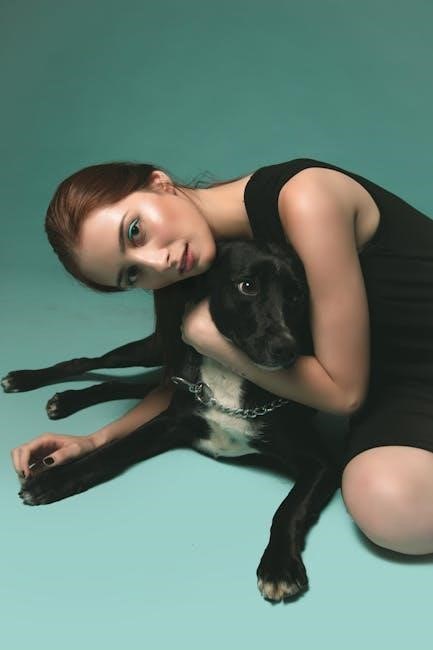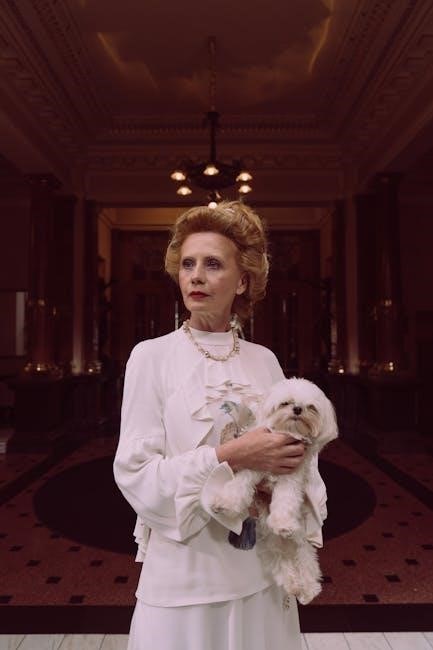Anton Chekhov’s “The Lady and the Dog” is a poignant short story exploring a chance encounter between Dmitri Gurov and a woman with her dog in Yalta.
Background and Significance
Anton Chekhov’s “The Lady and the Dog” is a masterpiece of late 19th-century Russian literature, first published in 1899. Set in the resort town of Yalta, the story captures the complexities of human emotions and societal norms. Chekhov’s concise yet profound writing style explores themes of love, morality, and personal transformation. The narrative centers on a chance encounter between Dmitri Gurov and a woman accompanied by her dog, unfolding into a deeper exploration of their inner lives. The story’s significance lies in its subtle psychological depth and its critique of societal expectations, making it a timeless classic in world literature. Its enduring appeal continues to inspire adaptations and interpretations.


Overview of the Story
“The Lady and the Dog” follows Dmitri Gurov, a middle-aged man dissatisfied with his marriage, who meets a young woman walking her dog in Yalta. Their initial interactions lead to a deep emotional connection, challenging Gurov’s views on love and life. The story explores themes of infidelity, personal growth, and the societal constraints of late 19th-century Russia. Through subtle dialogue and psychological insight, Chekhov portrays the complexity of human relationships, leaving the reader with a sense of melancholy and introspection. The narrative’s open-ended conclusion underscores the ambiguity of life, adding to its enduring literary appeal. This tale remains a profound exploration of the human condition.

Themes in “The Lady and the Dog”
The story explores themes of love, societal expectations, and personal growth, delving into the complexities of human relationships and emotional transformation in a restrictive society.
Love and Relationships
The story delves into the complexities of love and relationships, portraying the illicit affair between Dmitri Gurov and the lady with the dog. Their connection begins as a casual encounter but evolves into a profound emotional bond, challenging their perceptions of love. Gurov, married but unfulfilled, finds unexpected depth in his relationship with the lady, who is also trapped in a loveless marriage. The narrative explores the tension between romantic love and societal expectations, highlighting the personal sacrifices and inner turmoil that accompany such relationships. Through their journey, Chekhov examines the transformative power of love and the human longing for genuine connection in a restrictive society.
Societal Norms and Expectations
In “The Lady and the Dog,” Chekhov critiques the rigid societal norms of late 19th-century Russia, particularly the expectations surrounding marriage and adultery. Both Gurov and the lady are trapped in loveless marriages, reflecting the societal pressure to prioritize social standing over personal happiness. The story highlights the double standards of the time, where men like Gurov could engage in affairs with relative impunity, while women faced severe judgment for similar actions. The clandestine nature of their relationship underscores the suffocating moral codes that governed their lives. Chekhov’s portrayal of these constraints serves as a commentary on the stifling effects of societal expectations on individual freedom and emotional fulfillment.
Character Analysis
Anton Chekhov masterfully portrays characters trapped by societal norms, exploring their emotional depth and moral dilemmas. The story delves into universal themes of love, identity, and human flawed complexity.
The Lady with the Dog
The lady with the dog, whose name remains unknown, is a central figure in the story. She appears on the Yalta seafront with her small dog, capturing the attention of Dmitri Gurov. Married yet emotionally unfulfilled, she embodies the societal constraints placed on women. Her relationship with Gurov sparks a deep emotional connection, revealing her desire for meaning beyond her mundane life. The dog symbolizes her role as a nurturing figure, while her interactions with Gurov highlight her inner conflict. Chekhov portrays her as a complex character, trapped between duty and passion, reflecting the universal struggle of individuals seeking fulfillment in a rigid society.
Dmitri Dmitritch Gurov

Dmitri Dmitritch Gurov is a middle-aged man who becomes infatuated with the lady with the dog in Yalta. Initially, he views the encounter as a casual affair, typical of his past indiscretions. However, their connection deepens, revealing his inner emptiness and dissatisfaction with his life. Gurov’s character evolves from a detached, cynical individual to someone grappling with profound emotions. His transformation underscores Chekhov’s exploration of human longing and the search for genuine connection. Through Gurov’s journey, the story highlights the complexities of love and the societal masks people wear, ultimately illustrating the universal quest for meaning and authenticity in relationships.
Symbols and Motifs

The dog serves as a symbolic catalyst, initiating the connection between Gurov and the lady. Its presence underscores themes of innocence and subtle transformations in relationships.

The Dog as a Symbol
The dog in Chekhov’s story symbolizes innocence and spontaneity, contrasting with the artificiality of Gurov’s life. Its presence sparks the initial encounter, representing chance and simplicity. The dog embodies purity, highlighting the superficiality of societal norms. It also serves as a silent witness to the unfolding relationship, emphasizing the quiet, unspoken connections between characters. The dog’s role is subtle yet profound, reflecting themes of genuine emotions versus pretense. Its presence underscores the idea that true meaning can emerge from unexpected, simple moments, challenging the characters’ conventional views on love and life.

Cultural and Literary Impact
Anton Chekhov’s “The Lady and the Dog” has left a lasting impact on world literature, inspiring numerous adaptations and interpretations that highlight its timeless themes and emotional depth.
Adaptations and Interpretations
Anton Chekhov’s “The Lady and the Dog” has been adapted into various films, stage plays, and literary reinterpretations, each offering unique perspectives on the story’s themes. The 1960 Soviet film The Lady with the Dog, directed by Iosif Kheifits, remains a celebrated adaptation, staying faithful to the original narrative while enhancing its emotional depth. Stage productions have also explored the story, emphasizing the subtleties of human relationships. Additionally, scholarly analyses in PDF formats have dissected the story’s symbolism, such as the dog representing chance encounters and the complexities of love. These adaptations and interpretations continue to highlight the story’s enduring relevance and universal appeal.
Legacy of the Story

Anton Chekhov’s “The Lady and the Dog” has left an indelible mark on world literature, celebrated for its nuanced exploration of human emotions and relationships. Its concise yet profound storytelling has influenced writers and filmmakers globally. The tale’s timeless appeal lies in its universal themes of love, longing, and societal constraints, resonating with readers across generations. Academic studies and PDF analyses highlight its literary significance, often praising Chekhov’s ability to convey complexity through subtlety. The story’s legacy endures as a cornerstone of literary education, continuing to inspire adaptations and interpretations while remaining a vital part of cultural discourse.
Chekhov’s “The Lady and the Dog” remains a timeless tale of love and societal constraints, offering profound insights into human emotions and relationships, ensuring its enduring literary relevance.

Final Thoughts on the Story
Chekhov’s “The Lady and the Dog” masterfully captures the complexity of human emotions and societal pressures. The story’s subtle yet profound exploration of love, duty, and personal freedom resonates deeply with readers. Through the characters of Gurov and the lady, Chekhov illustrates the tension between desire and responsibility, leaving a lasting impression on the audience. The narrative’s open-ended conclusion invites reflection, emphasizing the enduring relevance of its themes. This tale remains a cornerstone of literary excellence, offering insights into the human condition that continue to inspire and provoke thought.

